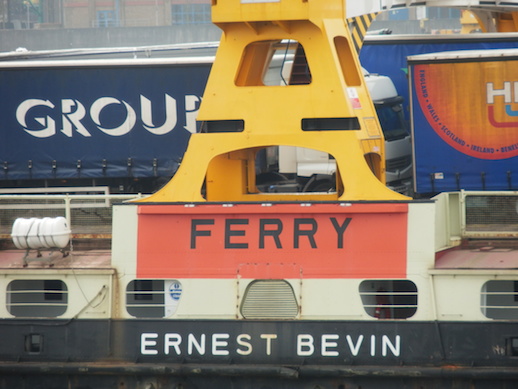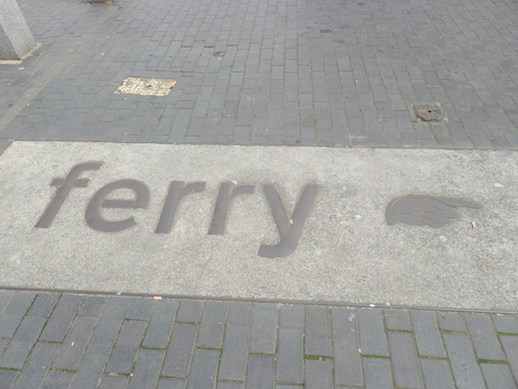The Woolwich Free Ferry
Words and pictures by Melissa Mouchemore.
“A day the like of which few localities have upon their records, and one which for complete success has at no time or place been ever surpassed.”
No one could accuse William Thomas Vincent, editor of the Kentish Independent, of underplaying the opening of the Woolwich Free Ferry in 1889. And looking at photographs of the Victorian throng that day; a sea of bowler hats, policemen’s helmets, sea cadets’ caps, banners held aloft, flags flying, brass bands marching, a triumphal arch of flowers declaring “Success to the Ferry!”, it is easy to see that if you had not got out much (and of course watched no telly, surfed no net) you really might think this was the greatest opening ceremony the world had ever seen. You see, I am not the only one to get excited by ferries. I am just possibly living in the wrong century.
On a Spring day 115 years after this grand event I stepped off the DLR at King George V station curious to see how the ferry was faring after such an illustrious beginning. I had heard talk of closure and Boris muttering something about a replacement service at Galleon’s Reach. I knew the current vessels from the early 1960s were, after half a century of serving as the only eastern link between the North and South Circular, overdue retirement. At the station exit the word ‘ferry’ looked reassuringly permanent at least, concreted and asphalted into the pavement. A gauntleted hand next to the word firmly pointed the way. Through the council estate, past Costcutters and lo! A queue of light haulage vehicles coming into view – an encouraging sight for any ferry spotter. Beyond this the Thames at low tide; dull metallic water, charcoal lines on the far bank suggesting high rise blocks and storage units. The two ferries on duty today, the Ernest Bevin and the James Newman, were the only moving vessels on the river. They worked in formation, curving elliptically from bank to bank, a continuous methodical stirring of the mainly undisturbed Thames. The queue of traffic stood by, quiet, docile, waiting to be led.
I was aware of a lorry driver above me in his cab watching as I squeezed my way between his vehicle and the next. An oddity I must have seemed, car-less, all other human life enclosed behind windscreens and steering wheels.
Foot passengers used to be much less of an oddity on the Woolwich ferry. Black and white photos from the the days when the ferries were paddle steamers show small boys with pinched faces and girls with big bows in their hair peering round corners and leaning over handrails.
“If there is any place in the boat where they ought not to be … the boys of a certainty will discover it.” said The London in 1896.
There are many accounts of ‘days out’ on the Woolwich ferry. Families taking picnics on board, a bracing breath of fresh air on deck considered a cure for whooping cough. A free ride on a free ferry with so much to see – the river busy with barges and tugboats, the stokers in the engine room . I wondered now as I walked down the path for foot passengers, whether current health and safety regulations would allow families to take up residence for the day and children to discover the places they ought not to be. Judging by the ubiquitous high vis bibs the crew were required to wear it seemed unlikely.
Whilst the traffic was being herded above, I as the only foot passenger was directed below.
A line painted across the polished green lino showed the way. Past a separate room with ‘Smoking’ etched into the pane of glass in its door. Next to which had been slapped the more familiar ‘No Smoking’ symbol. The door was also padlocked I noticed, just to make it quite clear.
I studied a large board entitled Procedure In The Event Of An Emergency where crew duties were outlined for ‘fire, collision and man overboard.’ Not that I was expecting trouble but I had been impressed by an account of the steamer ferry in a pea souper drifting down Woolwich Reach unable to secure its moorings and everyone spending the night on board. These days fog shuts down the ferry service. Even swaddled in a metropolis of regulations, natural forces still rule on the river.
PASSENGERS ARE ADVISED TO REMAIN SEATED UNTIL THE VESSEL HAS BERTHED said a sign.
There were acres of available wooden slatted benches to remain seated on but it was just too tempting to lean over the open rail and examine the river at close quarters. It mushroomed and churned releasing the tang of something wild. I started to feel that slight but familiar uplift – we were off! – and an eagerness to be outside up top.
Compared to the isolation below there was a bit of a crowd upstairs. Several drivers had been tempted out and were now chatting, a woman leaned against her car and gazed out. The generous width of the Thames seemed to have a relaxing effect on everyone. Even a high vis chap put his feet up for a mo, plastic chair rocked back on two legs. Standing in the small triangle of the top deck allocated for foot passengers I scanned the view. Looking back to the north bank a line of trees marked the remains of the old Royal Pavilion Pleasure Gardens where tea dances were regularly held and nearby the brickwork of the foot tunnel rotunda glowed against a backdrop of concrete and rubble. Upstream the bracelet of the Thames Barrier glinted. Only out here on the water, away from all the mess, were these charms revealed.
The ferries side-stepped each other midstream, laden with lorries. ‘Connect’ one of them announced along its flank.
The official line is that Woolwich is on the brink of regeneration and is becoming ever better ‘connected’ – Crossrail stations either side of the river, extended DLR. A grimy ferry might not fit into the shiny vision for a redeveloped waterfront. As we neared the south bank I wondered what the planners were going to do about the dour glass and brick fortress of the Waterfront Leisure Centre looming next to the ferry terminal. And the miles of cracked paving and facades sprouting buddleia. Sales and Marketing Suite a banner declared hopefully across the front of a Georgian building.
As I waited for the gate to open I thought of a plaque I had seen on the wall of the lower deck. Precious Places it had said with a quote:
“The ferry has been a constant in my life – the only thing that hasn’t changed round here since I was a boy.”
I know it is easy to lapse into nostalgia and natural to resist change, but I do feel protective towards the ferry and I am sure I am not the only one. I love the glimpse it gives me of maritime adventure as I plod through the urban haze.
Then again maybe the ferry doesn’t need protecting – it saw off its only recent vehicle carrying rival; in 2008 ambitious plans for the Thames Gateway Bridge were scrapped.
So let’s shout a hearty Victorian style ‘Hoorah!’.
Success to the Woolwich Free Ferry!

